Brompton, Middlesex
| Brompton | |
| Middlesex | |
|---|---|
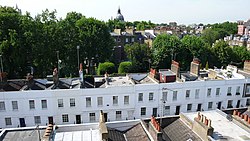 Walton Street, Brompton | |
| Location | |
| Grid reference: | TQ274790 |
| Location: | 51°29’42"N, 0°9’50"W |
| Data | |
| Population: | 8,839 (2011) |
| Post town: | London |
| Postcode: | SW3, SW5, SW7, SW10 |
| Dialling code: | 020 |
| Local Government | |
| Council: | Kensington and Chelsea |
| Parliamentary constituency: |
Chelsea and Fulham |
Brompton, sometimes called Old Brompton is an old village now deep within the townscape by Kensington in Middlesex. Until the latter half of the 19th century it was a scattered village made up mostly of market gardens lying south-east of the village of Kensington, abutting the parish of St Margaret's, Westminster at the hamlet of Knightsbridge to the north-east, with Little Chelsea to the south. It was bisected by the Fulham Turnpike, the main road westward out of London to the ancient parish of Fulham and on to Putney and across the river to Surrey. It saw its first parish church, Holy Trinity Brompton, only in 1829.
Today the village has been comprehensively eclipsed by segmentation due principally to railway development culminating in London Underground lines,[1] and its imposition of station names, including Knightsbridge, South Kensington and Gloucester Road as the names of stops during accelerated urbanisation, but lacking any cogent reference to local history and usage or distinctions from neighbouring settlements.[2]
Brompton has been home to many writers, actors and intellectuals.[3] The Survey of London gives a long list.[4] Its name survives formally to this day, only just, in the shared reference to two of the council's electoral wards called, "Brompton" and "Hans Town".[5]
Kernal of the village
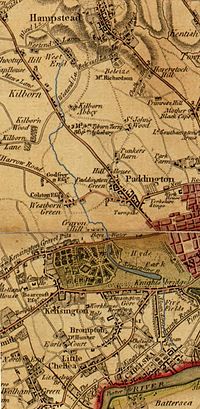
Where the old turnpike highway (Fulham Road) meets today's Thurloe Place and becomes Brompton Road is sometimes called Brompton Cross. The old village of Brompton carried on straddling the secondary Brompton Lane, later Old Brompton Road, for the whole of its length. In modern terms Old Brompton centred on today's South Kensington tube station, Gloucester Road tube station and their contiguous streets, and continued all the way to West Brompton station, between Earl's Court and Thames-side Chelsea.[6] The historian F.H.W. Sheppard has summarised it thus:
"there was always much traffic on the old turnpike road, which linked London not only with Little Chelsea and Fulham but also (via Putney Bridge) with parts of Surrey as well, and which from 1726 to 1826 was maintained by the Kensington Turnpike Trustees. Anciently, the eastern end of this highway was known indiscriminately as the road to Fulham or the road to Brompton. The name ‘Brompton’, now used loosely, then applied most precisely to the settlement which lay westwards of what is now South Kensington Station, just off the turnpike road along the lane to Earl's Court. This lane, generally called Brompton Lane or Bell and Horns Lane, diverged from the main road at the Bell and Horns, an inn sited opposite the [Brompton Oratory], where Empire House now stands. After the frontages of Brompton Road nearer London had been built up, the original nucleus of Brompton became known as Old Brompton and Brompton Lane as Old Brompton Road—which name survives today except in the short stretch east of South Kensington Station, where its line is represented by Thurloe Place. Before 1863 therefore, ‘Brompton Road’ was in general an unofficial term, usually to be construed as meaning the part of the Fulham turnpike road connecting Knightsbridge with Brompton Lane and thus with Old Brompton." [7]
History

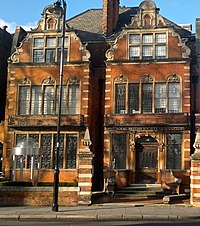
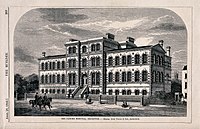
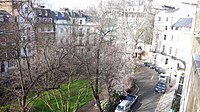

The first recorded mention of Brompton dates back to 1292.[8] It was a rural area which subsequently attracted attention as the story of developments centred along a turnpike road that ran south westward from London through Knightsbridge Green and horticultural Brompton to Little Chelsea and the ancient parish of Fulham on the banks of the Thames and thence over Putney Bridge to Surrey.[9] Brompton Park Nurseries were founded in 1681 by four leading gardeners, led by George London. In the late 18th century, Carey's map of 1787 shows Brompton as a collection of market gardens.[10] A hundred years later, Charles Dickens, Jr. (eldest child of Charles Dickens) wrote in his 1879 book Dickens's Dictionary of London that:
- "Brompton was at one time almost exclusively the artists' quarter and is still largely frequented by the votaries of the brush and chisel, though of late years Belgravia has been encroaching upon its boundaries, and Belgravian rents are stealing westward."[11]
The village gained its first church in 1829, Holy Trinity Brompton, rapidly incepted a parish.[12]
The gradual fragmentation and overshadowing of Brompton was probably due to two factors: the Great Exhibition of 1851 and the rapid institutional developments in the area, such as museums and colleges; and the arrival of railway transport.[13] The station built in 1868 on the Metropolitan and District Railways to serve the attendant crowds was named South Kensington, not "Brompton". A "Brompton Road station" opened in 1906 for the new Great Northern, Piccadilly and Brompton Railway; lack of passengers forced it to close in 1934. Gloucester Road tube station on the other hand, which had opened 1868, was originally called "Gloucester Road, Brompton", but for simplicity dropped the Brompton from its name. Thus, Brompton ceased to be a place or destination. A nod to Brompton resurfaced in 1866 with Sir John Fowler's "station in the middle of fields", West Brompton station.[14]
References
- ↑ Edward Walford, 'Underground London: Its railways, subways and sewers', in Old and New London: Volume 5 (London, 1878), pp. 224–242
- ↑ Edward Walford, 'The western suburbs: Knightsbridge', in Old and New London: Volume 5 (London, 1878), pp. 15–28
- ↑ Tames, Richard. (2000) Earl's Court and Brompton Past. London: Historical Publications. ISBN 0 948667 63 X
- ↑ {{brithist|50029] Survey of London Artists, musicians and writers resident in Brompton, 1790–1870
- ↑ Royal Borough of Kensington and Chelsea list of wards
- ↑ Walker, Dave (2014-03-13). "The Red Portfolio: More Tales of Old Brompton". rbkclocalstudies.wordpress.com. https://rbkclocalstudies.wordpress.com/2014/03/13/the-red-portfolio-more-tales-of-old-brompton/.
- ↑ 'Brompton Road: Introduction', in Survey of London: Volume 41, Brompton, ed. F H W Sheppard (London, 1983), pp. 1–8
- ↑ Brompton – half-forgotten, on "Hidden London"
- ↑ F H W Sheppard, ed (1983). "British History Online: Brompton Road: Introduction, in Survey of London". pp. 1–8. http://www.british-history.ac.uk/survey-london/vol41/pp1-8..
- ↑ Tames, Richard (2000). Earl's Court and Brompton Past. London: Historical Publications. ISBN 0-948667-63-X.
- ↑ Charles Dickens, Jr. (1879). "Brompton". Dickens's Dictionary of London. http://www.victorianlondon.org/dickens/dickens-bic.htm. Retrieved 2007-08-22.
- ↑ "Brompton New Church". Morning Post (London). 8 June 1829. http://www.britishnewspaperarchive.co.uk/viewer/bl/0000174/18290608/028/0003.
- ↑ F H W Sheppard, ed (1983). "Survey of London Volume 41, Brompton". British History Online. http://www.british-history.ac.uk/survey-london/vol41.
- ↑ 'The Kensington Canal, railways and related developments', in Survey of London: Volume 42, Kensington Square To Earl's Court, ed. Hermione Hobhouse (London, 1986), pp. 322–338. British History Online http://www.british-history.ac.uk/survey-london/vol42/pp322-338, fn.55 [accessed 15 October 2016].